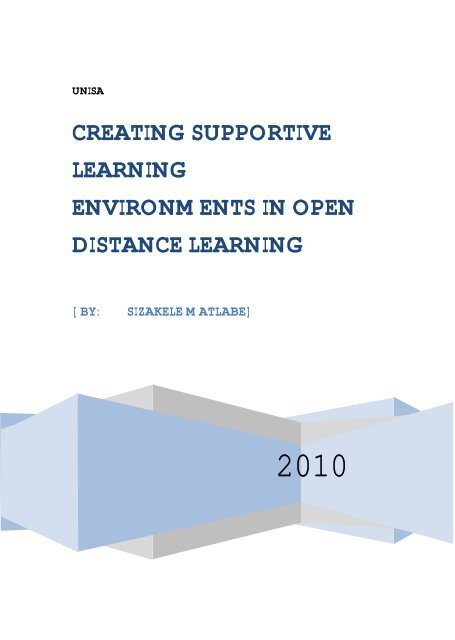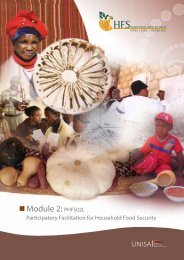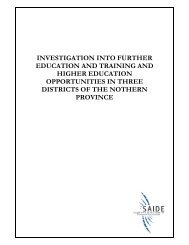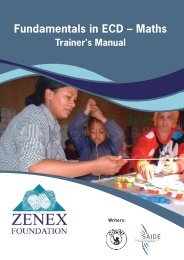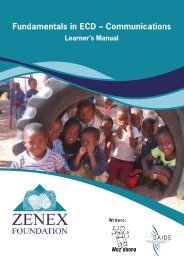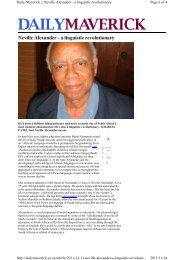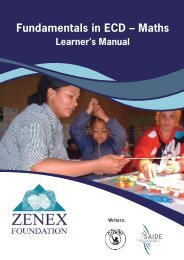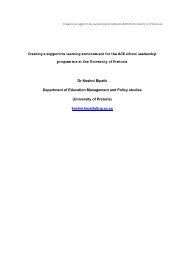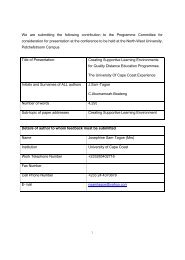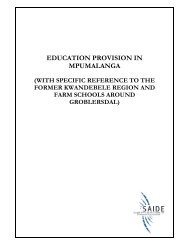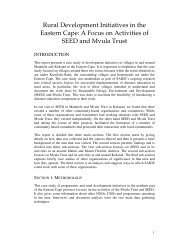creating supportive learning environments in open distance learning
creating supportive learning environments in open distance learning
creating supportive learning environments in open distance learning
You also want an ePaper? Increase the reach of your titles
YUMPU automatically turns print PDFs into web optimized ePapers that Google loves.
UNISA<br />
CREATING SUPPORTIVE<br />
LEARNING<br />
ENVIRONMENTS IN OPEN<br />
DISTANCE LEARNING<br />
[ BY: SIZAKELE MATLABE]<br />
2010
CREATING POSITIVE LEARNING ENVIRONMENTS IN AN ODL<br />
ABSTRACT<br />
Open Distance Learn<strong>in</strong>g (ODL) Institutions face a number of challenges <strong>in</strong> their efforts<br />
of provid<strong>in</strong>g quality assessment and <strong>creat<strong>in</strong>g</strong> <strong>supportive</strong> <strong>learn<strong>in</strong>g</strong> <strong>environments</strong> for their<br />
students who are miles away from the <strong>learn<strong>in</strong>g</strong> <strong>in</strong>stitution. The availability of new<br />
technology is forc<strong>in</strong>g ODL Institutions to change their traditional ways and methods of<br />
assess<strong>in</strong>g and monitor<strong>in</strong>g students’ progress and also improv<strong>in</strong>g the throughput rate.<br />
The purpose of this article is to discuss different approaches which can be used to<br />
overcome challenges <strong>in</strong>volved <strong>in</strong> reach<strong>in</strong>g the underserved students. Further, it<br />
suggests different assessment strategies and monitor<strong>in</strong>g methods which can be used to<br />
support <strong>learn<strong>in</strong>g</strong> <strong>in</strong> an ODL. The paper will also provide recommendations on how to<br />
create <strong>supportive</strong> assessment strategies <strong>in</strong> <strong>distance</strong> <strong>learn<strong>in</strong>g</strong> <strong>environments</strong> to ODL<br />
students.<br />
KEY WORDS: Throughput rate, assessment, <strong>creat<strong>in</strong>g</strong> <strong>supportive</strong> <strong>learn<strong>in</strong>g</strong><br />
<strong>environments</strong>, and <strong>open</strong> <strong>distance</strong> <strong>learn<strong>in</strong>g</strong><br />
`2
INTRODUCTION<br />
Open and Distance Learn<strong>in</strong>g (ODL) is one of the most rapidly grow<strong>in</strong>g fields of<br />
education. ODL has brought together a range of technologies that have enabled<br />
teachers and learners to overcome barriers <strong>in</strong> <strong>distance</strong> and time. These technologies<br />
have enabled <strong>distance</strong> teachers and learners who are separated by <strong>distance</strong> to<br />
communicate with each other <strong>in</strong> their flexible time. A direct outcome of this <strong>in</strong>dicates<br />
that access to education and <strong>learn<strong>in</strong>g</strong> opportunities are now suited to <strong>in</strong>dividual<br />
lifestyles, <strong>learn<strong>in</strong>g</strong> preferences and personal development plans. An ODL environment<br />
requires technological enable <strong>environments</strong> <strong>in</strong> order for it to be successful. An ODL<br />
approach focuses on <strong>open</strong><strong>in</strong>g access to education and tra<strong>in</strong><strong>in</strong>g provision, free<strong>in</strong>g<br />
students from the constra<strong>in</strong>s of time, place and offer<strong>in</strong>g flexible <strong>learn<strong>in</strong>g</strong> opportunities to<br />
<strong>in</strong>dividuals and group of students.<br />
This paper discusses the challenges which are faced by ODL <strong>in</strong>stitutions. The ma<strong>in</strong><br />
theme of this paper is; throughput rate. The other sub- themes are; assessments and<br />
<strong>creat<strong>in</strong>g</strong> positive <strong>learn<strong>in</strong>g</strong> <strong>environments</strong>.<br />
The study will be underp<strong>in</strong>ned by the post positivism theory, which emphasizes the<br />
importance of multiple measures and observations, each of which may possess<br />
different types or error to measure. It also holds the view that knowledge can only be<br />
regarded as valid and as real knowledge if it is objectives, arrived at by means of<br />
rigorous logical reason<strong>in</strong>g or scientific test<strong>in</strong>g and if it excludes values and emotions.<br />
PROBLEM OF THE STUDY<br />
Unisa has the highest number of enrolments and the lowest throughput rate when<br />
compared to other universities <strong>in</strong> South Africa (Pityane and Ndzimande, Unisa wise<br />
2009: 3& 5; Macfarlane, 2006). The most worrisome th<strong>in</strong>g is that Unisa has a variety of<br />
best technologies which they use to support their students and yet it seems they are not<br />
reach<strong>in</strong>g out to all the students. The <strong>open</strong>ness of Unisa and the entry requirements of<br />
students might contribute to the problem of low throughput rate. It is likely that Unisa is<br />
accessible to students who are unlikely to succeed because of their educational<br />
`3
ackground, some students register and quit before they could f<strong>in</strong>ish their first year.<br />
Some of the students are from rural areas characterized by low socio economic status<br />
and they are unable to pay their tuition fees as a result they will be forced to drop out of<br />
the system. A study which was conducted by Letseka ion dropout rates <strong>in</strong> contact<br />
universities can be used to generalized some of the challenges which might be the<br />
cause of low throughput rate at Unisa , (Letseka 2006:3 and Foster , 2009:301- 309).<br />
Pityane <strong>in</strong> an <strong>in</strong>terview with Dr Blade Nzimande m<strong>in</strong>ister of higher education, Professor<br />
Gourly and Dr Theeuns Eloff <strong>in</strong>dicated that Higher education <strong>in</strong>stitutions such as Unisa<br />
are faced with many daunt<strong>in</strong>g challenges all of which are <strong>in</strong>tertw<strong>in</strong>ed and co- contributor<br />
to the low throughput rate, (Unisa wise 2009: 3& 5). The aim of the study is to identify<br />
different ways that Unisa can implement <strong>in</strong> order to improve student’s throughput rate,<br />
and discuss how Unisa can best create positive <strong>learn<strong>in</strong>g</strong> <strong>environments</strong> for students,<br />
ensure that quality <strong>learn<strong>in</strong>g</strong> takes place and the university stands a chance of be<strong>in</strong>g<br />
successful.<br />
DATA COLLECTION METHODS<br />
Data was collected us<strong>in</strong>g policy documents, journals, research articles, and conference<br />
papers, research reports for masters’ and doctoral students and by mak<strong>in</strong>g detailed<br />
notes from the document mentioned above.<br />
Successful <strong>learn<strong>in</strong>g</strong> <strong>in</strong> an ODL can be achieved by us<strong>in</strong>g a comb<strong>in</strong>ation of technologies.<br />
Tutors, facilitators and course coord<strong>in</strong>ators play an important role <strong>in</strong> giv<strong>in</strong>g support to<br />
the students. Unisa has the best technologies compared with other <strong>in</strong>stitutions <strong>in</strong> South<br />
Africa, the question now is; are the lecturer’s us<strong>in</strong>g the appropriate, available,<br />
accessible and convenient technology to their students needs?. The most important<br />
th<strong>in</strong>g is that lecturer’s should be familiar with the use of technologies, learn how to<br />
operate the equipments , plan activities that will be familiar to the students , give<br />
students time to know each other. There should be a positive work<strong>in</strong>g relationship<br />
between lecturer’s, tutors and markers (International Association for cont<strong>in</strong>u<strong>in</strong>g<br />
education and tra<strong>in</strong><strong>in</strong>g).<br />
`4
DEFINITION OF TERMS<br />
Throughput rate: <strong>in</strong> this study throughput rate will mean the proxy for measur<strong>in</strong>g the<br />
proportion of enrolments graduat<strong>in</strong>g <strong>in</strong> a given year (Department of education (DoE)<br />
1996). In this paper it will mean the number of years taken to complete a qualification<br />
for which one is registered for.<br />
OPEN DISTANCE LEARNING (ODL): It refers to the philosophy of education provid<strong>in</strong>g<br />
students with choices and control over content and <strong>learn<strong>in</strong>g</strong> strategies. An ODL can be<br />
regarded as the <strong>learn<strong>in</strong>g</strong> which is <strong>open</strong> and accessible at any flexible time, duration,<br />
and at any geographical area. Therefore <strong>in</strong> an ODL students are provided by the<br />
chance to participate and succeed <strong>in</strong> their <strong>learn<strong>in</strong>g</strong> dur<strong>in</strong>g their leisure time.<br />
ASSSESSMENT<br />
Assessment is at the core of educational processes. Educational practices <strong>in</strong> most<br />
cases are built around new understand<strong>in</strong>g and realization that <strong>learn<strong>in</strong>g</strong> and assessment<br />
are essentially and <strong>in</strong>separable <strong>in</strong> the teach<strong>in</strong>g and <strong>learn<strong>in</strong>g</strong> processes. It is therefore<br />
imperative for lecturers to assess their students <strong>in</strong> order to determ<strong>in</strong>e if educational<br />
programs meet the <strong>in</strong>tended outcomes, (Merrell, Erv<strong>in</strong> & Gimpel, 2006:162 and Leach,<br />
Mc Comick, Moon, Murphy &Keynes, 2006: vii).<br />
Through the use of assessment students are able to identify their strengths’ and<br />
weaknesses <strong>in</strong> their own <strong>learn<strong>in</strong>g</strong>. Assessment when conducted properly can not only<br />
be used to provide feedback. It can also be used to enable students to make<br />
improvements and progress , students can also use it to self regulate their <strong>learn<strong>in</strong>g</strong> , it<br />
can f<strong>in</strong>ally help them <strong>in</strong> ga<strong>in</strong><strong>in</strong>g meta- cognitive skills and to develop as lifelong<br />
learners (Leach, McComick, Moon, Murphy & Keynes .2006: vii ; Asghar, 2010:495).<br />
Unisa with the use of its best technologies should consider enforc<strong>in</strong>g the use of<br />
synchronous onl<strong>in</strong>e <strong>learn<strong>in</strong>g</strong> <strong>in</strong> all programs which are offered <strong>in</strong> the university. Add<strong>in</strong>g<br />
synchronous <strong>in</strong>teraction <strong>in</strong> an ODL can provide significant changes and advantages on<br />
`5
the part of the learners, because the use of video conferenc<strong>in</strong>g for <strong>in</strong>stance allows realtime<br />
<strong>in</strong>teraction between the lecturer and the students. This can be used to allow<br />
students from different centres to <strong>in</strong>teract and clarify problematic read<strong>in</strong>g materials or<br />
concepts used <strong>in</strong> their study guides. Advantages of us<strong>in</strong>g video conferenc<strong>in</strong>g are that;<br />
students get immediately feedback. It reduces the feel<strong>in</strong>g of isolation. It also has the<br />
same effect and sense as the classroom. Students need to be given a special rem<strong>in</strong>der<br />
or assurance that they are not alone, neglected and ignored.<br />
THE USE OF TECHNOLOGY IN TEACHING AND LEARNING<br />
Distance education can be delivered through several modes <strong>in</strong>clud<strong>in</strong>g the<br />
follow<strong>in</strong>g; videocassettes, audiocassettes, audio teleconferenc<strong>in</strong>g, onl<strong>in</strong>e program on<br />
l<strong>in</strong>e or traditional face to face tutor<strong>in</strong>g, telephone, satellite broadcasts, discussions<br />
forums, short message system (s m s), emails and tutorial letters etc... whatever the<br />
mode of delivery which you th<strong>in</strong>k will be conducive and also support the process of<br />
teach<strong>in</strong>g and <strong>learn<strong>in</strong>g</strong> may be used. The objective of us<strong>in</strong>g different technology modes<br />
is to <strong>in</strong>crease access to education to those who have difficulty <strong>in</strong> access<strong>in</strong>g it with<strong>in</strong> the<br />
ma<strong>in</strong>stream. It is therefore a valuable tool that typically meets the needs of people who<br />
cannot be removed from their houses or job places for a long time. (Jegede, 2003).<br />
HOW DOES AN ODL OPERATE?<br />
ODL uses the student-centered approach to education. The success of an ODL<br />
depends solely on the use of variety technologies (Atk<strong>in</strong>som, 1998, 45-60 & Bates<br />
19996:9, Maxwell, 1995:46 and Tella 1997:1-17). The technologies perform two<br />
important functions; firstly they distribute <strong>learn<strong>in</strong>g</strong> materials, the second function is to<br />
stimulate <strong>learn<strong>in</strong>g</strong> by <strong>creat<strong>in</strong>g</strong> communication l<strong>in</strong>es, communication can take place<br />
between the students or the students and their lecturer’s (UNESCO, 2002:38, Ha<strong>in</strong>es<br />
2006: 13). However the theory and context which Maxwell’s (1995:46) def<strong>in</strong>ition on<br />
ODL and the use of technologies is applicable <strong>in</strong> the first world countries.<br />
The use of technology, <strong>in</strong>ternet and electronics has created a new common place for<br />
sources of <strong>in</strong>formation. It has made it possible for <strong>in</strong>formation to be transmitted over<br />
`6
land and ocean at a great and fastest speed. Through the use of <strong>in</strong>ternet students are<br />
able to access published electronic texts which are not available <strong>in</strong> the library. In a way<br />
the <strong>in</strong>ternet has brought about the concept of virtual classroom. Students and their<br />
lectures can use the <strong>in</strong>ternet to exchange documents or <strong>in</strong>formation over e—mail and<br />
ideas over electronic chats- sites, (Vakalisa, van Niekerk and Gawe <strong>in</strong> Jacobs, Vakalisa<br />
and Gawe, 2004: 155 &163). The <strong>in</strong>ternet usage shortens the <strong>distance</strong> between the<br />
students and physical library. The use of technology makes it possible for knowledge to<br />
be available <strong>in</strong> different ways other than the traditional way of us<strong>in</strong>g pr<strong>in</strong>t materials.<br />
The technologies however have limitations. Jacobs et al, (2004:163- 164) expla<strong>in</strong>ed that<br />
people who are poor and liv<strong>in</strong>g <strong>in</strong> rural parts of develop<strong>in</strong>g countries such as South<br />
Africa are unlikely to assess the <strong>in</strong>ternet. The lack of <strong>in</strong>frastructure such as; roads,<br />
electricity and low socio economic status poor network connection can h<strong>in</strong>der the use of<br />
technology <strong>in</strong> such areas.<br />
In reality most of the ODL students are found <strong>in</strong> deep rural areas <strong>in</strong> develop<strong>in</strong>g<br />
countries such as South Africa, Maxwell’s theory can be viewed as a dream which is<br />
farfetched. This is because; most students come from poor socio- economic<br />
<strong>environments</strong>, where- by they are unable to afford a computer, own<strong>in</strong>g a computer can<br />
be seen as hav<strong>in</strong>g leisure. This situation has led to a division or “digital divide” between<br />
the students <strong>in</strong> urban areas and those <strong>in</strong> rural areas. Therefore how does one beg<strong>in</strong> to<br />
talk about technology without divid<strong>in</strong>g the students <strong>in</strong>to two groups; “the haves” and the<br />
“have not”. In most cases “the haves” are the students <strong>in</strong> the urban areas who are<br />
connected to network whether <strong>in</strong> their work<strong>in</strong>g place or homes The” have not “on the<br />
other hand are students who are from deep rural areas, where there is poor network<br />
system, they cannot afford to buy themselves a computer hav<strong>in</strong>g access to <strong>in</strong>ternet is<br />
not a reality to them. The issue of us<strong>in</strong>g technology to reach out to students is still a<br />
thorny issue <strong>in</strong> develop<strong>in</strong>g world countries.<br />
Unisa has the best technologies which one can th<strong>in</strong>k of and also best strategies and<br />
<strong>in</strong>itiatives <strong>in</strong> place all this is done to meet the needs of students but unfortunately the<br />
university is sitt<strong>in</strong>g with a challenge of <strong>in</strong>creas<strong>in</strong>g its throughput rate. Most students <strong>in</strong><br />
`7
urban areas know how to operate a computer, whereas their counter parts <strong>in</strong> rural areas<br />
are computer illiterate. The digital divide also contributes <strong>in</strong> separat<strong>in</strong>g the rich from the<br />
poor (Jacobs et al, 2004:163- 164). Mutabi <strong>in</strong> Jacobs et al, (2004: 155) def<strong>in</strong>ed five<br />
ways of us<strong>in</strong>g <strong>in</strong>formation technology <strong>in</strong> teach<strong>in</strong>g and <strong>learn<strong>in</strong>g</strong>;<br />
Tutorial mode: the <strong>in</strong>formation is presented at the right time and level to cater for<br />
<strong>in</strong>dividual needs and potential. Support mode: the professional way <strong>in</strong> which work is<br />
presented develops confidence and a sense of self- esteem as learners learn to acquire<br />
computer skills. Exploration mode: the learner manipulates the computer for<br />
alternatives ways of <strong>learn<strong>in</strong>g</strong> and analysis data. `Resource mode: when l<strong>in</strong>ked to the<br />
<strong>in</strong>ternet, the learner may use the computer to f<strong>in</strong>d more <strong>in</strong>formation for projects. L<strong>in</strong>k<br />
mode: <strong>in</strong> advanced countries, l<strong>in</strong>ks can be made with learners from different localities to<br />
exchange <strong>in</strong>formation and share ideas. The e-mail l<strong>in</strong>ks helps to expedite requests and<br />
<strong>in</strong>formation.<br />
THE ADVANTAGES OF DIFFERENT USE OF TECHNOLOGIES IS THAT;<br />
It reaches people <strong>in</strong> communities <strong>in</strong> which they would otherwise be deprived of<br />
opportunities to learn. It equally makes a significant contribution by <strong>in</strong>creas<strong>in</strong>g people<br />
access to the education system; it gives room for people to start apply<strong>in</strong>g what they<br />
have learned almost immediately <strong>in</strong> their tra<strong>in</strong><strong>in</strong>g laboratory. The use of Technology<br />
enables students to grow academically and personally. It provides <strong>in</strong>teraction between<br />
students (students to students), faculty to students, student to resources, lecturer to<br />
tutor, tutor to students. It allows teach<strong>in</strong>g to be distributed <strong>in</strong>to different functions <strong>in</strong>stead<br />
of be<strong>in</strong>g controlled by one person, i.e. the lecturer. It reduces the barriers such as<br />
<strong>distance</strong> and time. Students <strong>in</strong> ODL use technology to close the gap which exists<br />
between them and their lecturers and class mates (McGregor and Basil, 2001:3).<br />
Unfortunately it is not everybody who is connected to the <strong>in</strong>ternet therefore alternatives<br />
should be derived to <strong>in</strong>clude all the students <strong>in</strong> the <strong>learn<strong>in</strong>g</strong>.<br />
`8
POSSIBLE CAUSES OF THE LESS THROUGHPUT RATE IN UNISA<br />
The high number of enrolments of students <strong>in</strong> Unisa is likely to be caused by the fact<br />
that tertiary education is now accessible even to those who appear unlikely to<br />
succeed ( Foster 2010: 301).<br />
Most of the Unisa students are from rural areas they cannot afford to pay the high tuition<br />
fees and as a result students are forced by lack of funds to drop along the way.<br />
Letseka <strong>in</strong> a Sowetan newspaper (2006:3), identified various entities that contribute to<br />
the less throughput rate at different universities. Some of the entities discussed <strong>in</strong>clude<br />
the follow<strong>in</strong>g; Students register and enter <strong>in</strong>to higher <strong>in</strong>stitute of education and quite<br />
before they f<strong>in</strong>ish their studies. The second th<strong>in</strong>g is that; some students do not have<br />
adequate skills to cope with the challenges of a place of higher <strong>learn<strong>in</strong>g</strong>.<br />
Statistics of dropout rates cited from the Department of Education 2005 report by<br />
Letseka (2006:3) <strong>in</strong>dicate that <strong>in</strong> 2000 there were 120 000 students enrolled <strong>in</strong> the<br />
<strong>in</strong>stitute of higher education. 30% (36 000) students dropped out <strong>in</strong> their first year of<br />
study. 20% (24 000) dropped out <strong>in</strong> their second and third year of study. Very few of the<br />
rema<strong>in</strong><strong>in</strong>g 60 000 (50%) graduated.<br />
The failure of poorly prepared undergraduate students is the ma<strong>in</strong> contribut<strong>in</strong>g factor<br />
towards the economic status of universities some universities may suffer a deficit<br />
(Foster, 2009: 316). The unpreparedness of undergraduate students is reflected by the<br />
low pass rates and the dysfunctional high schools of South Africa. Pityana (2006; 6)<br />
expla<strong>in</strong>ed that <strong>in</strong> 2005 the growth rate <strong>in</strong> students drop out rate and failure rate at Unisa<br />
has contributed to a deficit of R56, 6million. He further expla<strong>in</strong>ed that not all the courses<br />
are at risk. In this study at risk means the courses with high failure rate. Pityana also<br />
identified 20 courses which had a dropout rate of 95%.He also specified 4 degree<br />
programmes that show high dropout levels. The 4 programmes are: BSc is 80-90%,<br />
Social Sciences is 85 -86%, and B Com is 77-87 & BA Lang 83 for the 2001 cohort.<br />
This <strong>in</strong>formation is based on 2005 study current <strong>in</strong>formation was not use.<br />
`9
There are many other reasons which can force students to drop their studies along the<br />
way. Some of the reasons <strong>in</strong>clude the lack of support from lecturers, tutors and<br />
programme coord<strong>in</strong>ators, lack of positive <strong>learn<strong>in</strong>g</strong> environment just to mention a few.<br />
Table 2 below show shock<strong>in</strong>g statistics on the dropout rate <strong>in</strong> contact universities. Unisa<br />
was not part of the study, but this <strong>in</strong>formation can be used to generalize situations which<br />
take place <strong>in</strong> ODL <strong>in</strong>stitutions.<br />
Table 2: Higher education undergraduate drop-out rates, 2000-2003<br />
Progress of 2000 cohort of undergraduates (%)<br />
Universities Technikons Total<br />
Dropped out at the end of 2000 25 34 30<br />
Dropped out at the end of 2001 9 13 11<br />
Dropped out at the end of 2002 7 11 9<br />
Total dropped out 2000-2002 41 58 50<br />
Graduated <strong>in</strong> 2002 or 2003 26 19 22<br />
Study<strong>in</strong>g <strong>in</strong> 20003 but not complet<strong>in</strong>g 33 22 28<br />
Total <strong>in</strong> cohort 59 000 61 000 120 000<br />
Source: Department of Education (DoE) (2005) Student Enrolment Plann<strong>in</strong>g <strong>in</strong> Public<br />
Higher Education, Department of Education: Pretoria, December, cited by Letseka<br />
2007). Figure A below <strong>in</strong>dicates the high alarm<strong>in</strong>g numbers of dropout rates between<br />
the years 2000 to 2003 <strong>in</strong> contact universities of South Africa.<br />
Figure A: South Africa’s drop-out rate, 2000-2003<br />
`10
28%<br />
22%<br />
50%<br />
Dropped out <strong>in</strong> 2000-2003 Graduated <strong>in</strong> 2002 or 2003<br />
Study<strong>in</strong>g <strong>in</strong> 2003 but not complet<strong>in</strong>g<br />
Source: developed by author from the HSRC’s Student Pathways Study data <strong>in</strong> Letseka<br />
2007.<br />
CONCLUSIONS AND RECOMMENDATIONS<br />
After tak<strong>in</strong>g <strong>in</strong>to consideration the current situation of Unisa, I want to argue that the<br />
<strong>in</strong>stitution should revisit some of its policies and procedures of Admitt<strong>in</strong>g students,<br />
subsidiz<strong>in</strong>g students, distribut<strong>in</strong>g materials to students and the process of followed by<br />
students when send<strong>in</strong>g their assignments and projects. Unisa should ensure sure that<br />
every lecturer know and they <strong>in</strong>corporate different technologies <strong>in</strong> their teach<strong>in</strong>g.<br />
THE FOLLOWING RECOMMENDATIONS WERE SUGGESTED;<br />
In an ODL environment, positive <strong>learn<strong>in</strong>g</strong> does not happen by accident, it happens<br />
through direct result of actions taken by the lecturer. This <strong>in</strong>volves through preparation<br />
of <strong>learn<strong>in</strong>g</strong> programs, <strong>learn<strong>in</strong>g</strong> materials and assessment materials and activities which<br />
are student centered by approach.<br />
Rules and expectations should be stated with a positive language, this can be<br />
considered as the first step to <strong>creat<strong>in</strong>g</strong> a positive environment for <strong>learn<strong>in</strong>g</strong>. Lectures<br />
should spell it out <strong>in</strong> their tutorial letters what they will expect from the students, how<br />
they will assess them, attach rubrics which they will use for mark<strong>in</strong>g and <strong>in</strong>dicate the<br />
`11
outcomes they will use for assessment. If your <strong>learn<strong>in</strong>g</strong> outcomes are not stated clearly<br />
your assessment is likely to be <strong>in</strong>valid and reliable (Killen 2000: 24).<br />
Lecturer’s should understand their students and also know which k<strong>in</strong>ds of support and<br />
<strong>in</strong>struments they can use to ma<strong>in</strong>ta<strong>in</strong> a positive <strong>learn<strong>in</strong>g</strong> environment.<br />
Lecturers should design high quality ways of <strong>in</strong>teract<strong>in</strong>g with students from different<br />
spheres of life e.g. rich/ poor, rural or urban.<br />
ODL University should create a k<strong>in</strong>d of environment which will prepare students who<br />
are fresh from high school with the new environment never be<strong>in</strong>g exposed to before<br />
dur<strong>in</strong>g their high school life. In most cases students lack skills on time management,<br />
writ<strong>in</strong>g assignments research<strong>in</strong>g and read<strong>in</strong>g their study guides and also respond<strong>in</strong>g to<br />
the activities which are <strong>in</strong> the guide. The challenges also <strong>in</strong>clude us<strong>in</strong>g the different<br />
technologies available <strong>in</strong> the <strong>in</strong>stitution.<br />
New lectures need to be tra<strong>in</strong>ed and oriented about the ODL <strong>environments</strong>. They must<br />
know how it operates and what will be expected from them. This should take place<br />
immediately; the <strong>in</strong>stitution should not wait for a certa<strong>in</strong> period before orient<strong>in</strong>g the new<br />
staff. Lectures should be tra<strong>in</strong>ed to be catalyst of <strong>learn<strong>in</strong>g</strong>. They should know how they<br />
can catalyze student’s retention or <strong>learn<strong>in</strong>g</strong>.<br />
Unisa should consider tak<strong>in</strong>g read<strong>in</strong>g / pr<strong>in</strong>t material to a central po<strong>in</strong>t where students<br />
can collect them immediately after registration s<strong>in</strong>ce post<strong>in</strong>g the materials is not help<strong>in</strong>g;<br />
some students receive their materials very late this is one of the lame excuses they will<br />
give when submitt<strong>in</strong>g assignment after the stipulated due date. When the post office<br />
personnel / staff are on strike students will not get their read<strong>in</strong>g materials on time. This<br />
also affects the submission of assignment and projects by students.<br />
ODL <strong>in</strong>stitutions need to emphasize the use of discussion forums and study groups.<br />
Students can use onl<strong>in</strong>e or short message system (sms), which is accessible <strong>in</strong> their<br />
cell phones to <strong>in</strong>teract with each other from their different local takes place. The ODL<br />
`12
<strong>in</strong>stitutions should forge a way of promot<strong>in</strong>g reciprocal peer couch<strong>in</strong>g among the<br />
students. Lecturer can divide the students accord<strong>in</strong>g to their locations i.e., regions or<br />
prov<strong>in</strong>ces or they can just let the students decide on how to form their own study<br />
groups.<br />
Unisa should consider the use of Supplementary Instruction (SI). In SI the best students<br />
<strong>in</strong> the modules which will be identified as risk by the exam<strong>in</strong>ation department will be<br />
given a chance to teach, clarify, and assist their classmates/ peers <strong>in</strong> <strong>learn<strong>in</strong>g</strong>. This is<br />
done under a supervision of the primary lectures of the modules concerned. The SI<br />
leaders will have to go through tra<strong>in</strong><strong>in</strong>g, to master the different techniques and skills<br />
which they will use to force/ probe their peers to come up with correct answers or to<br />
understand difficult tasks.<br />
Unisa must th<strong>in</strong>k of decentraliz<strong>in</strong>g some of the activities to the central regional <strong>learn<strong>in</strong>g</strong><br />
centers which are found <strong>in</strong> all the prov<strong>in</strong>ces. Assignments should be collected accord<strong>in</strong>g<br />
to regions. Assignments which are from far away centers should be distributed <strong>in</strong> the<br />
nearby regional areas, and also the university should employ markers who are from<br />
those areas. Necessary arrangements for captur<strong>in</strong>g received or marked assignments<br />
should be done <strong>in</strong> the regional areas, <strong>in</strong>stead of wast<strong>in</strong>g time send<strong>in</strong>g assignments to<br />
Pretoria. When assignments are posted they travel through a lot of channels before<br />
be<strong>in</strong>g distributed to the markers. The same route will be taken when send<strong>in</strong>g them back<br />
to student a lot of time is be<strong>in</strong>g wasted through these channels and processes.<br />
Redistribution of study should be revisited. The study materials should be sent and<br />
distributed <strong>in</strong> regional <strong>learn<strong>in</strong>g</strong> centers. Students should be able to get their study<br />
materials immediately when they produce evidence or proof of registration. Students<br />
receive materials very late and this affect the schedule of assignment submission.<br />
Students who are technically <strong>in</strong>cl<strong>in</strong>ed should be encouraged to enroll at further<br />
education and tra<strong>in</strong><strong>in</strong>g colleges or university of technology. Students who are<br />
academically <strong>in</strong>cl<strong>in</strong>ed should be encouraged to explore options at universities, based on<br />
their academic strengths passions (Letseka 2006: 3 and foster 2009: 301, 309).<br />
`13
RESOURCES<br />
1. Asghar, A. (2010) ‘Reciprocal peer coach<strong>in</strong>g and its use as a formative<br />
assessment strategy for first year students; Assessment &EVALUATION IN<br />
Higher Education, 35:4,,403-417, first published on 10 July 2009.<br />
2. Atk<strong>in</strong>som, E. 1998. Open/flexible <strong>learn<strong>in</strong>g</strong> and the <strong>open</strong> Learn<strong>in</strong>g <strong>in</strong>itiative.<br />
Proceed<strong>in</strong>gs of the 22 nd International Conference on <strong>open</strong> <strong>learn<strong>in</strong>g</strong>.4-6<br />
December 1996. Old Australia, 45-48.<br />
3. Bates a. 1996. The impact of technological change on <strong>open</strong> <strong>distance</strong> <strong>learn<strong>in</strong>g</strong>.<br />
Key note presentation <strong>in</strong> proceed<strong>in</strong>gs of the 2 nd<br />
4. Department of education (DoE) 1996.<br />
5. Ha<strong>in</strong>es R. J. 2006. Overcom<strong>in</strong>g the technical challenges of provid<strong>in</strong>g <strong>distance</strong><br />
education to develop<strong>in</strong>g countries. Bowie state university. Europe<br />
6. http://cbdd.wsu.edu/edev/kenettot/unit1/unit1Agenda.htm<br />
7. International conference on <strong>open</strong> <strong>learn<strong>in</strong>g</strong>. 4-6 December. 1996. Brisbane. Old<br />
Australia.<br />
8. Jacobs. M, Vakalisa. N. C. G and Gawe. N, 2004. Teach<strong>in</strong>g and <strong>learn<strong>in</strong>g</strong><br />
dynamics a participative approach for OBE. Cape Town. He<strong>in</strong>emann.<br />
9. Leach .J, McCormick .R, Moon. B, Murphy. P and Keynes. M. 2006. Learners<br />
and pedagogy.<br />
10.Macfarlane, D. 2006. “Shock varsity dropout stats”. Mail & Guardian, 22 to 23<br />
September.<br />
11.Maxwell, 1995. Integrat<strong>in</strong>g <strong>open</strong> <strong>learn<strong>in</strong>g</strong> and <strong>distance</strong> .Educational technology<br />
November- Ddecember43-48.<br />
`14
12.McGregor and Basil 2001. Gender awareness <strong>in</strong> Information and Communication<br />
Technology (ICT) Education. African Education Review journal. Volume 6(2)<br />
November 2009.Routledge Unisa.<br />
13.Pr<strong>in</strong>slooo. P. 2010: 10, Focus staff news letter. April 2010: 10. Unisa publish<strong>in</strong>g<br />
company. Pretoria.<br />
14.Pr<strong>in</strong>slooo. P. 2010: 5. Focus staff news letter. May l 2010: 5. Unisa publish<strong>in</strong>g<br />
company. Pretoria.<br />
15.Tella, S. 1997.An uneasy alliance of media education and multiculturalism, with a<br />
view to foreign language <strong>learn<strong>in</strong>g</strong> methodology. Media education center.<br />
University of Hels<strong>in</strong>ki. Department of TEACHER education. Also available on<br />
l<strong>in</strong>e; http://www.hels<strong>in</strong>k.fi/~tella/ole/ole4odl.html<br />
16.UNESCO. March 2002:38. Teacher education guidel<strong>in</strong>es: us<strong>in</strong>g <strong>open</strong> and<br />
<strong>distance</strong> <strong>learn<strong>in</strong>g</strong>. The <strong>in</strong>ternational research foundations for Open Learn<strong>in</strong>g <strong>in</strong><br />
Cambridge. France<br />
17.Unisawise 2009:3 &5 challenges and solutions champions of higher education<br />
share their views, unisa publish<strong>in</strong>g company. Pretoria.<br />
`15


